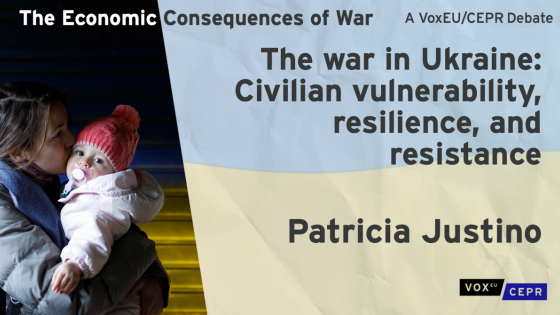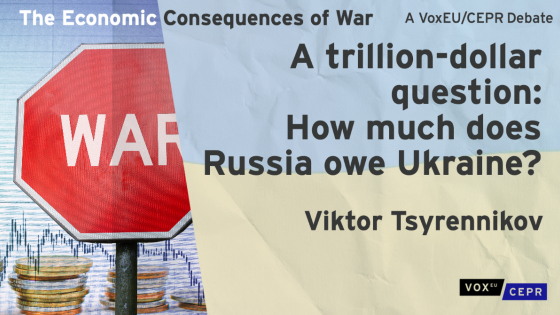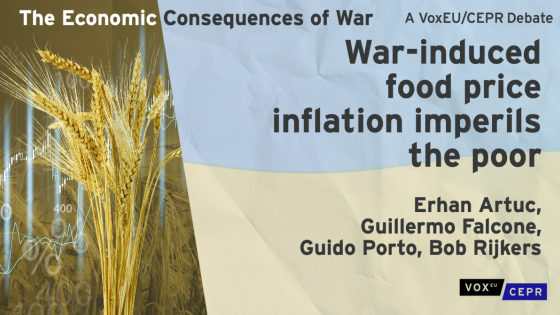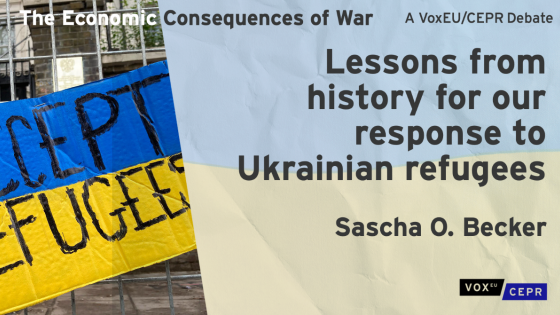Editors' note: This column is part of the Vox debate on the economic consequences of war.
Wars are one of the most significant drivers of poverty in the world today, affecting almost two billion people (World Bank 2020). The war in Ukraine will contribute to increasing this number further (Tsyrennikov 2022), with vicious cycles of war and poverty likely to emerge in Ukraine should the conflict become protracted, which increasingly appears a likely possibility. However, the welfare effects of wars are not uniform across affected populations. Some lose their lives and livelihoods, and endure fear and destitution. Others may do well and profit from war economies. Others – often the majority – simply get by. The most vulnerable will be those living in areas under siege like Mariupol, Kharkiv, Kherson, and Chernikiv, among others, where humanitarian support cannot reach those trapped, and where livelihoods and markets are being deliberately destroyed. Others better able to escape and with the means to survive may fare better. What explains this variation in the welfare consequences of wars for individuals and households?
My research has shown that the levels of vulnerability or resilience of civilians in wartime depend on three key factors (Justino 2009, 2012, 2013). The first is the magnitude, nature, and duration of the effects of violence committed by armed groups during the war. The second is the type and effectiveness of strategies that civilians are able (or allowed) to access to cope with the effects of the conflict. The third is the level and extent of how civilians exercise their own agency to shape the behaviour of armed groups that attempt to control them.
Effects of violence in wartime
Wars exercise a heavy toll on civilians via economic mechanisms (such as inflation, disruption of markets, shortages of food, fuel, and other essential goods, and loss of physical and human capital), psychological mechanisms (such as trauma and loss), and social mechanisms (such as displacement, misinformation, and loss of trust) (Blattman and Miguel 2010, Grosjean 2022, Justino 2012, Verwimp et al. 2019). All these mechanisms threaten the survival of individuals and households during wars, hinder the ability of affected households to recover in the post-conflict period (Justino and Verwimp 2013), and have spillovers elsewhere (Artuc et al. 2022). These mechanisms are currently all at play across Ukraine as infrastructure (including schools and hospitals), markets, and whole communities are being destroyed. Losses in human capital may be especially irreversible and last across generations. Research suggests that, even if the war in Ukraine ends soon, relatively minor shocks to human capital in children affected by the war (via nutritional or health effects and education losses) can cause long-lasting detrimental effects that will persist well after the conflict has ended, with long-term intergenerational consequences in terms of school achievement, health outcomes, and future earnings.1 These effects are made worse by forced displacement (Engel and Ibáñez 2007). The UN High Commission for Refugees (UNHCR) estimates that almost 4.5 million refugees (around 10% of its population) have left Ukraine since the start of the invasion on 24 February 2022.2 Ukrainian refugees are being welcomed by host countries, but nonetheless face great personal and social losses, which may affect their ability to reintegrate if return becomes challenging in the months to come (Becker 2022). Managing the return of these populations will be as challenging as managing their exit but must be a priority once violence subsides, as must the rebuilding of lost human capital.
Coping strategies and their effectiveness in the face of war
A large literature in development economics has shown how households living in risky economic environments, even the very poor, develop a complexity of (ex-ante) risk management and (ex-post) risk-coping strategies, including in conflict zones (Justino 2012). In the case of Ukraine, households are unlikely to have built ex-ante risk management strategies given how quickly the Russian invasion escalated. Ex-post risk-coping strategies are threatened by the focus of the Russian attacks on cities and the risks associated with urban warfare in highly populated cities.
A theoretical framework that I develop in Justino (2009) postulates that the long-term effectiveness of coping strategies adopted by households in war zones is dependent on two key sets of factors. The first is related to initial household characteristics, which determine their levels of vulnerability to poverty. The second is the likelihood of the household being targeted by violence during conflict, i.e. its vulnerability to violence. As with any other shock, the economic position of households at the start of the conflict is an important factor in how households adapt to violent conflict because it shapes their ability to, for instance, draw on savings and accumulated assets, adjust to losses in productive assets, and access new livelihoods when displaced. Households who possess assets and savings may therefore be in a better position to adapt to the impacts of the war. However, in situations of war, households face the possibility of being targeted by armed groups (Kalyvas 2006). Households facing selective forms of violence (such as some politicians and community leaders in Ukraine, for instance) will adopt coping strategies not only according to their economic needs, but also according to their perceived probability of being killed, displaced or looted, i.e. according to their level of vulnerability to violence (Justino 2009). This probability is defined by characteristics such as ethnic, religious, or other socio-cultural group membership, their geographic location, and their socio-economic status. Possible trade-offs between economic and physical survival distinguishes wars from other shocks: those that are poorer do not necessarily face the worst welfare consequences because some better-off households may be targets of violence due to specific initial characteristics. Any recovery plan in Ukraine will need to be based on an accurate assessment of the characteristics of the victims of war.
Civilian agency
Over the last five weeks, the war in Ukraine has been characterised by important military losses and gains on both sides. This has surprised many analysts since the Russian army was expected to dominate the course of the invasion. The reason it did not is largely explained by mounting civilian resistance. This interplay between civilian resistance and armed group control has been illustrated theoretically in Gáfaro et al. (2022). One way in which armed groups ensure the control of local communities is by capturing, co-opting, or controlling local organisations and replacing local leaders. This is illustrated by the capture and attempts at replacing mayors in Ukrainian cities under siege by Russian army. The capture and co-option of local institutions during wars has been well-documented from Germany and Italy in WWII (Satyanath et al. 2017, Riley 2005) to more modern civil wars (Arjona 2016). Civilians are not passive to these actions. Some may decide to support armed groups, while others may organise themselves to resist and repel armed groups and maintain their autonomy (Kaplan 2017, Krause 2018). As shown in Gáfaro et al. (2022), in equilibrium, armed groups capture organisations with a sufficiently high level of pre-existing institutional capacity, where they can reach a sufficiently large share of the population through these organisations. However, civilian resistance is also more likely in these settings, increasing the cost of capture for the armed group. Full dominance by armed groups that face large resistance is only possible in communities with weak institutional capacity, which may be less attractive to the group.
Understanding these complex interactions between armed groups and civilians during wartime is important because it may shape the course of the war and lead to different pathways of recovery in the post-conflict period. One important consequence in the case of Ukraine may be the transformation of ongoing civilian resistance into a sustained insurgency. Ordinary citizens are being armed to defend themselves and their communities and, as the war draws out, various militia, civilian defence forces and vigilante groups will form. This will result in the militarisation of civil society, which may be problematic as it may contribute to the erosion of social trust and trust in institutions of governance as the conflict endures (Bateson 2017). But it may also offer opportunities, especially if successful in mounting an effective resistance (Huang 2016, Kaplan 2017). Given evidence from other wars, the economic, social, and political recovery of Ukraine will be dependent not only on bringing refugees back and reconstructing markets and infrastructure, but also on ensuring that social cohesion and trust in institutions is rebuilt so that any Ukraine post-war government is able to succeed in maintaining a united population. The Ukraine war is causing unmeasurable suffering to civilians caught in the crossfire. But civilians may still shape the course of the conflict.
References
Akresh, R, S Bhalotra, M Leone and U Osili (2021), “First and Second Generation Impacts of the Biafran War”, Journal of Human Resources, forthcoming.
Akbulut-Yuksel, M (2014), “Children of War: The Long-Run Effects of Large-Scale Physical Destruction and Warfare on Children”, Journal of Human Resources 49(3): 634-662.
Alderman, H, J Hoddinott and B Kinsey (2006), “Long Term Consequences of Early Childhood Malnutrition”, Oxford Economic Papers, 58(3): 450-474.
Arjona, A (2016), Rebelocracy: Social Order in the Colombian Civil War, New York: Cambridge University Press.
Artuc, E, G Falcone, G Porto and B Rijkers (2022), “War-induced food price inflation imperils the poor”, VoxEU.org, 1 April.
Bateson, R (2017), “The Socialization of Civilians and Militia Members: Evidence from Guatemala”, Journal of Peace Research 54(5): 634-647.
Bauer, M, C Blattman, J Chytilová, J Henrich, E Miguel and T Mitts (2016), “Can War Foster Cooperation?”, Journal of Economic Perspectives 30(3): 249-274.
Becker, S (2022), “Lessons from history for our response to Ukrainian refugees”, VoxEU.org, 29 March.
Blattman, C and E Miguel (2010), “Civil War”, Journal of Economic Literature 48(1): 3-57.
Bundervoet, T, P Verwimp and R Akresh (2009), “Health and Civil War in Rural Burundi”, Journal of Human Resources, 44(2): 536-563.
Camacho, A (2008), “Stress and Birth Outcomes: Evidence from Terrorist Attacks in Colombia”, American Economic Review 98(2): 511-15.
Engel, S and A M Ibáñez (2007), “Displacement Due to Violence in Colombia: A Household-Level Analysis”, Economic Development and Cultural Change 55: 335-365.
Gáfaro, M, A M Ibáñez and P Justino (2022), “Community Organization and Armed Group Behavior: Evidence from Colombia”, WIDER Working Paper.
Grosjean, P (2022), “Conflict, empires, and political preferences”, VoxEU.org, 28 March.
Huang, R (2016), The Wartime Origins of Democratization: Civil War, Rebel Governance, and Political Regimes, New York: Cambridge University Press.
Justino, P, M Leone and P Salardi (2014), “Short and Long-Term Impact of Violence on Education: The Case of Timor Leste”, World Bank Economic Review 28: 320-353.
Justino, P, T Brück and P Verwimp (2013), A Micro-Level Perspective on the Dynamics of Conflict, Violence and Development, Oxford University Press.
Justino, P and O Shemyakina (2013), “Remittances and Household Labor Supply in the Post-Conflict Tajikistan”, IZA Journal of Labor and Development 1: 8.
Justino, P and P Verwimp (2013), “Poverty Dynamics, Violent Conflict and Convergence in Rwanda”, Review of Income and Wealth 59(1): 66-90.
Justino, P (2013), “Research and Policy Implications from a Micro-Level Perspective on the Dynamics of Conflict, Violence and Development”, in P Justino, T Brück and P Verwimp (eds), A Micro-Level Perspective on the Dynamics of Conflict, Violence and Development, Oxford University Press.
Justino, P (2012), “War and Poverty”, in M Garfinkel and S Skaperdas (eds), Handbook of the Economics of Peace and Conflict, Oxford University Press.
Justino, P (2009), “Poverty and Violent Conflict: A Micro-Level Perspective on the Causes and Duration of Warfare”, Journal of Peace Research, 46(3): 315-333.
Kalyvas, S N (2006), The Logic of Violence in Civil Wars, Cambridge: Cambridge University Press.
Kaplan, O (2017), Resisting War: How Communities Protect Themselves, New York: Cambridge University Press.
Kondylis, F (2010), “Conflict Displacement and Labor Market Outcomes in Post-War Bosnia and Herzegovina”, Journal of Development Economics 93(2): 235-248.
Krause, J (2018), Resilient Communities: Non-Violence and Civilian Agency in Communal War, Cambridge University Press.
La Mattina, G (2017), “Civil Conflict, Domestic Violence and Intra-Household Bargaining in Post-Genocide Rwanda”, Journal of Development Economics 124(3): 168-198.
Riley, D (2005), “Civic Associations and Authoritarian Regimes in Interwar Europe: Italy and Spain in Comparative Perspective”, American Sociological Review 70(2): 288–310.
Satyanath, S, N Voigtlaender and H-J Voth (2017), “Bowling for Fascism: Social Capital and the Rise of the Nazi Party”, Journal of Political Economy 125(2): 478-526.
Shemyakina, O (2011), “The Effect of Armed Conflict on Accumulation of Schooling: Results from Tajikistan”, Journal of Development Economics 95(2): 186-200.
Tranchant, J-P, P Justino and C Muller (2020), “Political Violence, Adverse Shocks and Child Malnutrition: Empirical Evidence from Andhra Pradesh, India”, Economics and Human Biology 39.
Tsyrennikov, V (2022), “A trillion-dollar question: What Russia owes Ukraine”, VoxEU.org, 6 April.
Verwimp, P, P Justino and T Brück (2019), “The Microeconomics of Violent Conflict”, Journal of Development Economics 141: 1-6.
World Bank (2020), Fragility and Conflict: On the Frontlines of the Fight Against Poverty, World Bank, Washington, D.C.
Endnotes
1 A large body of research has documented the human capital effects of civil wars across most conflict-affected countries, including on education (Akbulut-Yuksel 2014, Justino et al. 2014, Shemyakina 2011), health (Akresh et al. 2021, Alderman et al. 2006, Bundervoet et al. 2009, Camacho 2008, Tranchant et al. 2020), gender relations (La Mattina 2017), labour outcomes (Justino and Shemyakina 2013, Kondylis 2010) and poverty (Justino and Verwimp 2013). For reviews see Blattman and Miguel (2010), Justino (2012), Justino et al. (2013), and Verwimp et al. (2019).
2 https://data2.unhcr.org/en/situations/ukraine



